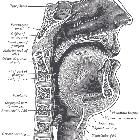Musculus geniohyoideus






The geniohyoid muscle is one of the suprahyoid muscles of the neck that is innervated by the ventral ramus of C1. Geniohyoid draws the hyoid bone up and forward during mastication and assists the opening of the mandible.
Summary
- origin: inferior mental spine of the mandible also known as the genial tubercle
- insertion: upper border of the body of the hyoid bone
- innervation: anterior rami of C1 spinal nerve
- action: paired muscle pull the hyoid bone and larynx up and forwards during swallowing; when the hyoid bone is fixed geniohyoid acts to depress the mandible and open the mouth
Gross anatomy
Origin
The geniohyoid is a paired slender ribbon of muscle that originates from the inferior mental spine on the posterior surface of the mandibular symphysis.
Insertion
The geniohyoid muscle inserts on to the anterior and upper surface of the body of the hyoid bone.
Relations
The paired geniohyoid muscles lie adjacent to one another and are immediately superior to the mylohyoid muscles on the floor of the mouth and inferior to the genioglossus muscles that form the roof of the mouth.
Blood supply
The geniohyoid muscle receives branches from both the lingual and facial arteries.
Innervation
The geniohyoid muscles are innervated by a branch of the ventral ramus of C1 from the cervical plexus which courses with the hypoglossal nerve in to the floor of the mouth. The branch is thus not from the hypoglossal nucleus and is unable to be seen in superficial dissections of the neck due to overlying mylohyoid muscles.
Action
As the geniohyoid muscle contracts it pulls the hyoid bone and with it the attached larynx upwards and forwards during swallowing. Conversely when the hyoid bone is fixed the geniohyoid muscles acts synergistically with the mylohyoid muscles to depress the mandible and pull it inwards thus opening the mouth.
Siehe auch:
und weiter:

 Assoziationen und Differentialdiagnosen zu Musculus geniohyoideus:
Assoziationen und Differentialdiagnosen zu Musculus geniohyoideus:
